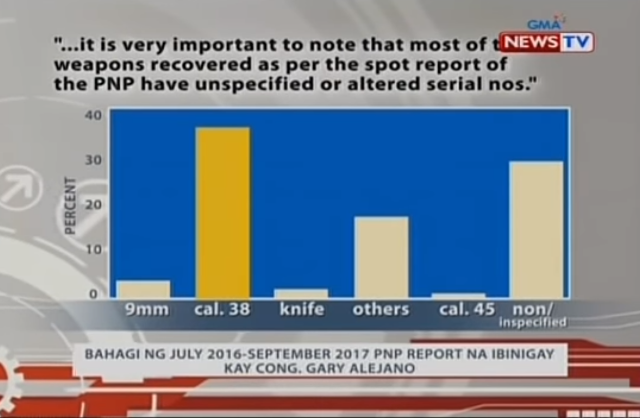GMA News Probes Integrity of Evidence in Drug Ops

Screengrab from GMA News’s Youtube account.
CHEERS TO GMA News for a report that returned to a major aspect of police conduct in the government’s war on drugs. In a story that aired both on GMA-7’s 24 Oras and GMA News TV’s State of the Nation with Jessica Soho, reporter Mariz Umali looked into whether the guns supposedly taken from crime scenes, including from those killed for allegedly “fighting back”in the course of Philippine National Police (PNP) anti-drug operations indeed exist and are in safekeeping.
In reporting anti-drug operations, the media often include police statements saying that the suspect was killed because he or she “resisted arrest,” and was carrying a gun.
The police have been accused many times of planting weapons to justify the killings, which they have consistently denied. But the question remains: What do they do with these confiscated firearms, if they had indeed been wielded by slain drug suspects?
Citing spot reports which Rep. Gary Alejano (Magdalo party-list) gave to the PNP, GMA News reporter Mariz Umali said that based on around a thousand police records from July 2016 to September 2017, 37% of the guns were caliber .38 “paltik,” orhomemade guns,which she said are usually cheap and easily obtainable.
Still referring to the spot reports, Umali said that a large number of the retrieved weapons had no indicated make or model. She said some of the guns’ serial numbers were either not mentioned in the reports or, quoting Alejano, have been “defaced”.
If this is the case, Alejano told Umali that the guns could be “recycled,” meaning used again and again as “evidence” in those instances when the police say the drug suspects they killed fought back. That possibility prompted him to request access to the facility where the guns are supposedly being kept, but he is still awaiting the PNP’s response.
Umali herself said she asked the police whether she can enter the depository, but was told that the evidence room is a restricted area.
Senior Supt. Benigno Durana, Jr., spokesperson of the PNP, told Umali that “criminals” usually deface the serial numbers so that the guns cannot be traced, but the police have a way of tracking the weapons. He did not elaborate on how the tracking system works.
Umali explained the protocol in storing the guns recovered from crime scenes as follows:
The PNP Scene of the Crime Operatives (SOCO) takes them for processing andturns the firearms over to the PNP Crime Laboratory once a case against the suspect is filed in court.
When the case has been resolved, the weapons are either turned over to the PNP Firearms and Explosives Office or “demilled,” meaning the weapons are cut into pieces.
The GMA News report was a good follow-up to a similar Philippine Star story that CMFR had cheered in January 2017 (See: “Guns and Gaffes: Finding the Story in the Data“). The Star referred to police records as well, pointing out the “strange coincidence” that some of the guns recovered from Quezon City police operations had the same serial numbers.
The GMA News story provided many leads for other media organizations to follow in reporting possible irregularities in police anti-drug operations. Armed with the information provided in previous reports, journalists should be able to raise more questions about the integrity of police evidence, particularly the guns supposedly used by drug suspects slain for “fighting back,” as well as to critically examine and evaluate the veracity of official police documents.
Leave a Reply